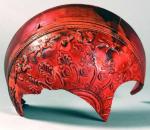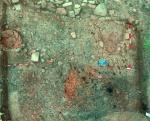Summary (English)
EXCAVATIONS NEAR THE VILLAGE OF SINEMORETS (Daniela Agre – daniela.agre@abv.bg, Deyan Dichev) The explorations were concentrated at the southwestern part of the fortification wall. A drainage channel was excavated, going out through the western fortification wall. Sherds and an Olynthus Mill were found in the channel. A fragmentary ceramic strainer, pots, an amphora and a bowl were found in front of the inner side of the fortification wall. The western part of House I was explored. Burned timber beams were discovered. Burned acorns, a fragmentary krater, dishes, a Megarian bowl and a dolium were discovered on the floor level. A hearth was excavated, surrounded by fragments from imbrices. A clay eschara was discovered at 1 m from the hearth, surrounded by roof-tiles. In Trench I9, the postholes in the bedrock were completely explored. In trench Y9, a hearth and a fragmentary dolium in situ were discovered close to the fortification wall. A house probably existed in these two trenches. Two pits were excavated in the northern sector of the site, one of them containing a layer of burned fragmentary wattle-and-daub and charcoal, and sherds, including from red-gloss pottery. The pottery from the Western Sector dated to the second half of the 2nd – beginning of the 1st centuries BC; it is Thracian and Greek, imported from Anatolia, including amphorae from Kos and Knidos. The Thracian tyrsis (residential tower) existed during the last quarter of the 2nd – beginning of the 1st centuries BC and was destroyed by fire. During the first half of the 1st century BC, a pottery kiln was constructed over the debris. During the 1st – 2nd centuries AD, pits were dug into the northwestern part of the site. In the northeastern part of the site, five Christian burials, dug into the Late Hellenistic stratum, were excavated to the east of the apse of the church. Grave No. 35 belonged to a woman, buried with gilded silver jewelry and a ceramic jug. Grave No. 1 of a woman was entirely excavated and a headscarf with brocade and with pinned bronze jewelry was found. The church and the cemetery dated to the 18th – 19th centuries.
- Daniela Agre - Archaeological Institute with Museum
- Deyan Dichev - Archaeological Institute with Museum
Director
Team
Research Body
- Archaeological Institute with Museum






![Download [PDF]](/excavation/skins/fasti/images/results/download_sml.png)
